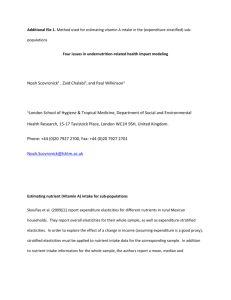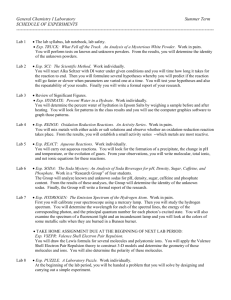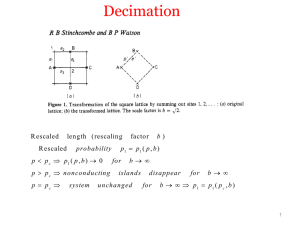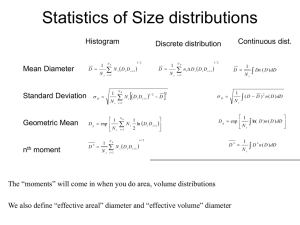Document 10438848
advertisement
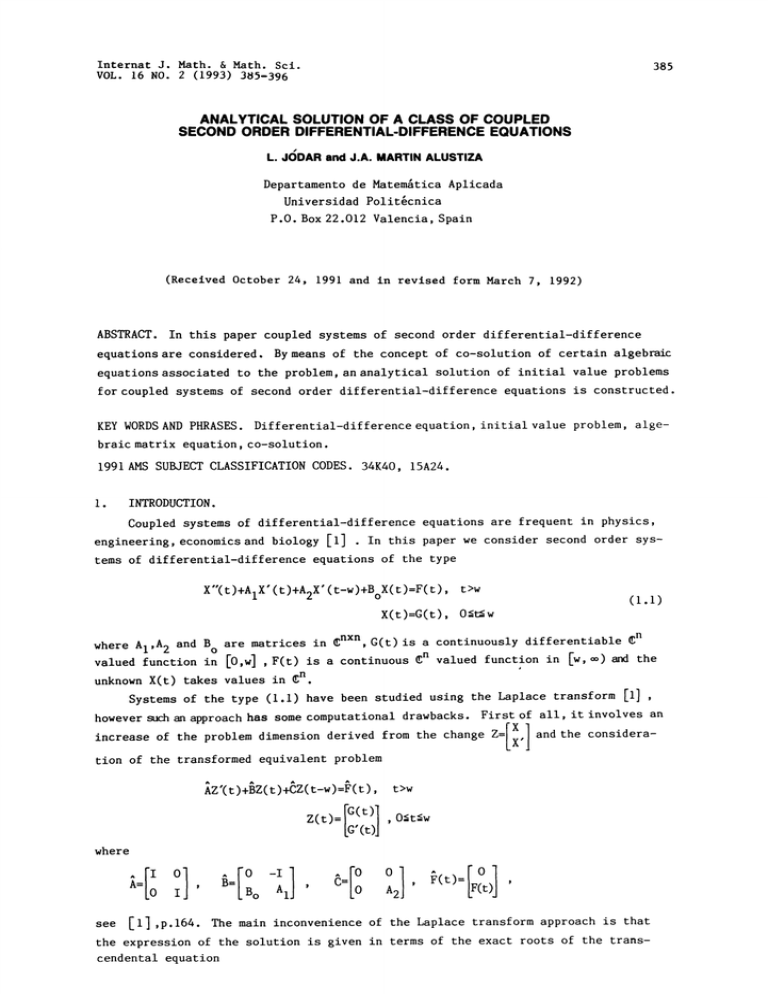
Internat J. Math. & Math. Scl.
VOL. 16 NO. 2 (1993) 35-396
385
ANALYTICAL SOLUTION OF A CLASS OF COUPLED
SECOND ORDER DIFFERENTIAL-DIFFERENCE EQUATIONS
L.
J(OAR and J.A. MARTIN ALUSTIZA
Departamento de Matemtica Aplicada
Universidad Politcnica
P.O. Box22.012 Valencia, Spain
(Received October 24, 1991 and in revised form March 7, 1992)
ABSTRACT. In this paper coupled systems of second order differential-difference
equations are considered. By means of the concept of co-solution of certain algebraic
equations associated to the problem, an analytical solution of initial value problems
for coupled systems of second order differential-difference equations is constructed.
initial value problem, alge-
KEY WORDS AND PHRASES. Differential-difference equation,
braic matrix equation, co-solution.
1991 AMS SUBJECT CLASSIFICATION CODES. 34K40, 15A24.
l.
INTRODUCTION.
Coupled systems of differential-difference equations are frequent in physics,
In this paper we consider second order sysengineering, economics and biology [I]
tems of differential-difference equations of the type
X"(t)+AlX’(t)+A2X’(t-w)+BoX(t)=F(t),
t>w
(1.1)
X(t):G(t), Ow
where A
I,A 2
and
G(t) is a continuously differentiable n
Bo are matrices isinanxn,
continuous n valued function in [w, ) and the
valued function in [O,w] F(t)
unknown X(t) takes values in
Systems of the type (i.i) have been studied using the Laplace transform [i]
however suchanapproach has some computational drawbacks. First of all, it involves an
and the consideraincrease of the problem dimension derived from the change
n.
z=[Xrx.
tion of the transformed equivalent problem
Z’( t )+Z( t )+6Z(t-w) :
Z(t)=
t ),
t>w
O_<t=<w
[G(t)],
[G,(t)j
where
o]
I
Ill ,p.164.
o
Bo
AI
A2
1
(t
The main inconvenience of the Laplace transform approach is that
the expression of the solution is given in terms of the exact roots of the transcendental equation
see
386
L. JODAR AND J.A.M. ALUSTIZA
det
see
[I],p.166
(s+)+exp(-sw)6)=O
[I],
and Theorem 6.5 of
Since the exact computation of these rootsis
not available in practice, the Laplace transform
method is not interesting from the
of
and
it motivates the search of an alternative.
view,
computational point
The aim of this paper is to construct the exact solution of problem (i.i) in an
explicit way, avoiding the increase of the problem dimension and the determination of
roots of transcendental equations. The method proposed here is based on the concept
of co-solution of the associated algebraic matrix equation
Z2+AIZ+B
recently given in
[2].
o
(1.2)
--0
The paper is organized as follows. In Section 2, and for the
sake of clarity in the presentation, we adapt some results of [2] related to problem
(1.1). We introduce an integral operator and we prove some of its properties that
will be used in Section 3 in order to construct the solution of problem (l.1).
T
we denote by A the transpose matrix of A. The set of
If A is a matrix in
nxm
all repeated variations of two elements taken of r elements in r elements will be de-
noted by
Q2,r"
ALGEBRAIC PRELIMINARIES AND PROPERTIES OF AN INTEGRAL OPERATOR.
We begin this section by introducing the concept of co-solution of the equation
(1.2), recently given in [2] which allows us to solve initial value problems for
2.
_
second order differential equations without considering an extended first order system.
DEFINITION 2.1
equation (1.2) if XE
[2]
DEFINITION 2.2
We say that
+...+mk=2n
). We say that (X,T) is a (n,q) co-solution of the algebraic
X#O, TE qxq and
[2] ). Let (Xi,Ti) be a (n,m i) co-solution of equation (1.2).
k} is a k-complete set of co-solutions of (1.2) if ml+m2+
nxq,
{(Xi,Ti),
KT2+AIKT+BoX=O.
and the block matrix W defined by
w:[Xl
[XIT
is invertible in
Xk
XkTk
X2
X2T2
1
2nx2n.
]
(2.1)
The next result shows the existence of k-complete sets of co-solutions of (1.2),
for some appropriated value of k, and it permits the construction of such sets of cosolutions.
THEOREM i
[2 ])
Mi3nxmj,
Let
C=
0
Bo
M=(Mij) an invertible matrix in nx2
ml+m2+,..+mk=2n, such that for some block diagonal
]
and let
i 2, iSjk,
matrix J=diag(J I,
Jk) one satisfies MJ=CM. Then equation (1.2) admits a k-comfor ljSk.
plete set of co-solutions given by
such that
(MIj,Jj),
(MIj,Jj) ljk
be a k-complete set of co-solutions
COROLLARY
[2] ). Let
of equation (1.2), then the general solution of the system
X"(t)+AiX" (t)+BoX(t)=O
is given by
k
X(t)=j=I 1 Mljexp(tJj )Dj
(2.2)
SOLUTION OF A CLASS OF COUPLED SECOND ORDER DIFFERENTIAL-DIFFERENCE EQUATIONS
where D. is an arbitrary vector in mj
387
for l.<j.<k
Now we are looking for the general solution of the system
X"(t)+AIX" (t)+BoX(t)=P(t),
(2.3)
where P(t) is a continuous function. Let us consider the k-complete set of co-solutions given by corollary i, and let us denote
V=W-I=
[2]
From
Vlk T
V2kJ
Vll V12
V21 V22
V.. mjxn
i2,
ljk
(2.4)
lj
(2.3)
it follows that the general solution of
is given by
k
X(t)=
j=iZ M13.exp(tJj )mj (t),
Dj(t)=Dj
where
=Co,
+texp(-uJ’jwj)V2jP(u)du
is an arbitrary vector in
Dj.
X’(w)=C I,
with C
o,C 1
(2.5)
mj
vectors in
(2.6)
For fixed initial conditions X(w)
for l-<j<-k.
n,
the vectors
Dj,
l.<j.<k, are determined by the
equations
k
k
Co
and since
I M ljexp(wJj)D
j=l
M2j=MIjJ j,
see
CI= jZ=IMIjJjexp(wJj)D j
J’
[2], from
(2.7)
(2.7)
it follows that
-I
Diag(exp(-wJj); l-<j.<k) M
el
k
REMARK i.
It
is interesting to recall that the Jordan canonical form of any
MACSYMA
[
,so taking into account Theorem
i, the construction of a k-complete set of co-solutions for equation (1.2) is an easy
of a Jordan block
matter. On the other hand, we recall that the exponential
matrix may be efficiently computed using
exp(tJj)
Jj, has a
well known expression in terms of
Jj,
see
[4 ] ,p.66.
Now we introduce an integral operator that will play an important role
in the
following.
ljk} be the k-complete set of co-solutions of
and
p be positive integers with hp, and tpw,
(1.2) provided by Theorem I. Let h
valued and defined on [w,)
where w is a positive real number. If H is continuous
DEFINITION 2.3.
Let
{(Mlj,Jj);
n
we define the operator
by the expression
[p,h,t,j, H(Uh+d-W(d+n))
388
L. JODAR AND J.A.H. ALUSTIZA
t
hw
exp(-uhJj)V2jH(Uh-nW)duh
if p=h
(2.9)
g
exp(-UpJ.)V2jj
P-I’P- Lip_2,P_2
) eQ2,
"ip-l’ip-2’
.L,h H(Uhd-W(d+n)) %,
if p>h
where n--O,l; h<.q<-p-l; l<-i <.2,
q
Uq+l+d-(d+l)w
k
L l,q
=A2
Z M
jq=l
jqJjqep ((Uq+l+d-(d+l) w)Jjq
)]qw
exp(-UqJj q)V2j q dUq
(2.o)
k
L2, q=A2
Z M
V2
jq--i jq jq
and d is the number of factors of the type L
of the type L
or
H(Uh+d-W(d+n))
which appear on the left of each factor
2
before the appearance of a new factor L I.
EXAMPLES
[3,2, t, j ,H(U2+d-dW)]
a)
I
t
3w
exp(-u3Jj)V2j
k
t
Z
n.
(i2)EQ2, I ,2
H(U2+d-dW)du3--
u3-w
k
I
t
I3weXp(-u3Jj)V2j A2 J2=lMI j2V2j 2H(u3-w)du3
[1,l,t,j,H(Ul+d-dW)
b)
]=I
[3,1,5w, j, H(U2d-(d+l)w)
c)
j exP(-j)V2jA2
t
w
exp(-ulJj)V2jH(Ul )dul
=I 3wp(j)V2j (’il)eQ2,:,2Lil H(UDd-(d+l)
k
j2g--1MIJ2 J2
J2
w
Sw
?"
j2--I
k
3-
J exp((u3-w)J
l u2-Wexp(-ulJj )V2j H(Ul-W)dUldU2du
(-u3Jj)V2jA2
w) du3
Z
12w exp(-2Jj2)V2J2A Jl- It"MI:J.jljlep((u2-w)J’l
2
3 +
F.
J2 Jj2exp((u3-w)Jj2 exp(-u2JJ2)V2J2A2 jl=1
2w
k
exp(-u3Jj)V2jA2 Z=I M 132 V 2
3w
J2
k
j2A2 Jl-Z_l M jlV2j iH(u3-3w)du3
.
V
+
Jl 2JlH(u2-2w du2du3
SOLUTION OF A CLASS OF COUPLED SECOND ORDER DIFFERENTIAL-DIFFERENCE EQUATIONS
to construct
Now we prove two lemmas that will be used in the following section
the solution of problem (i.I).
LEMMA i. If t>.(m+l)w and h<.p=<m, then for n=O,l, it follows that
[p+l,h,t,j,H(Uh+d_(d+n)w)]= [p+l,h,(m+l)w,j,H(Uh+d-(d+n)w)]
+
k
t
389
(2.)
k
d
d--( [p,h,t,Jm,H(Uh+d-(d+n)w)] )t__z_w] dz
MlJmeXp((z-w)Jjm)
jm-_
+ I
From definition 2.3 it follows that
PROOF.
[p+l ,h, t, j ,H(Uh+d-(d+n)w)]
t
I(p+lexp(_Up+iJj)V2j
,p-I ...L, h H(Uh+d-(d+n)w)dUp+l
)EQ2,p+l-h ip,p ip_1
(m+l>
r.
exp(-up+IJj)v2j
(p+l
(ip,
t
+IJ(m+l)wexp(-u_.P+,J .)V.z3
(ip
.
exp(-Up+iJj)V2j
(p+l)w
+itm+l)w
exp(-zJ.)Vzj
3
L.
..L,
L.
L.
)g Q2,p+l-h Ip,p
X
j
h
H(Uhd-(d+n)w) dUp+
+
lh,h H(Uh+d-(d+n)w) dUp+
)eQ2,p+l_h lp,p
L, H(Uh+d-(d+n)w) dUp+
L.1 ,p
p
X
(lp
)eQ2, p+l-h
k
Y’
Jm exp((z-w)Jjm) iz
Jm=l
L
L
l
(p’p-i
-
h
+
exp(-u J.. )V.
P
pw
Jm ZJm
k
t
Z
)eQ2,p_h
(ip_
p_l,P_l...L,
H(uo_(d+n)w)dudz+
v
h
"
exp((z-w)J
exp(-zJ)VA Z M..
ljm
Jm
(m+l)w
Jm=l
L. ,p_l...L, h H(Uh+d_(d+n)w)) dUp)
l
t--z-w
(-U/jm)V2Jm (ip-1 ’)gQ2,p-h
xp-1
d(
dt
dz
of the lemma
Hence we obtain the right hand side of (2.11) and the proof
LEMMA 2. If t>=(m+l)w, h<=p<.m and n=O,l,
m+l
p-I
Z (-i)
p=h
m
y.
p=h
{(_l)hH(z_nw)+k2[j
k
+
m
k
1Mlj:jm exp((z_w)jjm)
m
j=l MljmeXp((z-w)JJm) p=h(-1)P-1
F.
d ((I)
dt
I
concluded.
it follows that
(2.12)
[P,h,t,j,H(Uh+d-( d+n)w)]
(_l)P-i [p,h,(m+l)w,H(Uh+d_(d+n)w)]
is
I
t
exp(-zJ V 2 j
J
(m+l)w
(_I)P-1 )[p,h,z_W, Jm,H(Uh+d-(d+n)w]
[p,h,t, Jm’ H(Uh+d-(d+n)w)] )t--z-w
]
dz
+
(2.13)
390
L. JODAR AND J.A.M. ALUSTIZA
PROOF. From definition 2.3 and lemma I,
m+l
Z
p=h
(-i)h-1
m-I
+
k
7.
m
p=h+l
(-I)P-I O[p,h,t,j,H(Uh+d_(d+n) w)]
it(m+lexp(-zj)V23A
k
2
{jm=17" MlJmJJmeXP((z-w)Jjm)[p,h,z-W,Jm, H(Uh+d-(d+n)w)] +
M1%exp((z-w)Jjm) d( 0 [p,h,t,Jm,H(Uh+d-(d+n)w)]
)t=z-w
dz
+
23 =l%JjmeXP((Z-W)Jjm O[m’h’z-W’Jm’H(Uh+d-(d+nlw)]
exp(-zJ .)v
]
(ml-1)w
k
+ 7.
+
[m+l,h,t,j,H(Uh+d_(d+n)w
(-I)p
p=h7"
(-l)P-I [p,h,t,j,H(Uh+d_(d+n)w)]
O[h,h,t,j, H(Uh+d-(d+n)w ] +
(-l)m
+
it follows that
+
MI exp((z-w)J )d-( [m,h,t,Jm,H(Uh+d-(d+n)w)] )t=z-w ] dz=
jm=
t
k
t
-13 (m+l)wexp(-zJ’)V323
=(-l)h-i [) (m+l)wexP(-Z/")V/4(z-nw)dz
z3
k
m
X (-I) p-I
p=h
(-I)p-I
[p,h,z-w,H(u..-(d+n)w)]
+
n---
7.
_.
Hence the proof of lemma 2
exp((z-w.
Jm=lOm
d( [P,h,t,Jm, H(Uh+d-(d+n)w)]
)_
exP((Z-W
._lJmJJm
t=z-w
Jm
dz
is established.
CONSTRUCTION OF THE SOLUTION.
In this section we provide an analytical expression for the solution of problem
(i.i) by means of a constructive way. Note that for t>w the system (I.i) may be
3.
written in the form
X"(t)+AIX" (t)+BoX(t)--F(t)-A2X" (t-w),
t>w
(3.1)
X(t)=G(t) for O-<w. From(2.5)-(2.8), thesolution of (3.1) on the interval
[w,2w] is given by (2.5) where Di(t) takes the form
where
t
Dj(t)--Dj(w)
+I exp(-zJj)V2j {F(z)-A2X’(z-w)}
w
dz
SOLUTION OF A CLASS OF COUPLED SECOND ORDER DIFFERENTIAL-DIFFERENCE EQUATIONS
In general, for
whereDj(t)
tg[mw,(m+l)w]
391
the solution of (3.1) may be written in the form (2.5)
is given by
t
Dj(t)=Dj (mw)+[mw exp(-zJj)V2j F(z)-A2X" (z-w)
ue[O,w], it
Taking into account that X(u)=G(u) for
(3.2)
follows that
t
t
Dj(t)=Dj(w)
te[mw, (m+l)w]
dz
exp(%)V2jF(z)dz
w
I weXp(-zJj)V2jG
tg[w,2w]
(z-w)dz
(3 3)
and from (2.5) and (3.3), we have
k
y"
X(t)=j=l Mljexp(tJJ )Dj (t)=
k
t
t
(3.4)
j--1
w
tg[2w,3w], one
If
gets
It exp(-zJj)V2jA2X"
t
Dj (t)=Dj (2w)+i 2w exp(-zJj)V2j F(z)dz
(z-w)dz
2w
and from (3.3)-(3.4), it follows that
I
2w
I
Dj(t)=Dj(w)+ w exp(-zJj)V2jF(z)dz
2w
w
exp(-zJj)V2jA2G’(z-w)dz
k
t
Jl
Jl=lJl Jl
k
z-w
Jw
+
exp(-uJj
)V2JlA2G’(u-w)du
+
jZ ljlexp((z-w)Jjl exp(-(z-w)Jjl)V2
j
F(z-w) +
-exp(-(z-w)Jjl)V2JlA2G’(z-2w)]}dz
k
=Dj(w)-
weXp(-zJj)V2jA2 Jl
.t
t
E MI
=I
jlJJl exp((z-w)Jj I)Djl (w)
k
dz +
z-w
k
t
-f2weXp(-zJj)V2jA2 Jl=IZ MljlV2jlF(z-w)dz
+!2wexp(-zJj)V2jA
+I2wexp(-zJj)V2jA
z-w
k
t
2
2
I MIj
Jl=l
Z M
(3.5)
iJJl exp((z-w)Jj
I A2G’(z-2w)d
Jl=l Jl
z
fw
exp(-uJj
)V2JlA2G’(u-w)dudz
exp(-zJj)V2jA2G’(z-w)d z
Now by using the induction principle we are going
to prove that the solution of
392
L. JODAR AND J.A.M. ALUSTIZA
(i.i) for
operator
tE[mw,(m+l)w],
m
m
p=l
.
k
E (-1) p-1 [p,2,t,j,
Dj(t)=Dj(w)+ p=2
+Z
(2.5) where
is given by
in the form
I
Dj(t)
is expressed in terms of the
J. exp((u.
z..,-(d+l)w)Jj
Jl=1 31 31
)Dj (w)]
+
(-1)P-l@[p,l,t,j,F(Ud+l-dW)]+(-l)m [m,l,t,j,A2G’(Ul+d-(d+l)w)]
+
m
+Z {(-I) p-I [p-l,l,pw,j,
p=2
r=p+l
(3.6)
k
m
Z (-i)r-I
A2G’(Ul+d-(d+l)w)] +
[r,p+l,t,j,
Z
jp=l
j/jpeXp((Up+l-W)Jjp)[p-l,l,pw,jp,A2G’(u
l+d
1
-( d+l )w)]
It is easy to prove that in (3.3)-(3.5), Dj(t) coincides with (3.6) for m=l,2. Let us
suppose that for tE[mw,(m+l)w] ,Dj(t) is given by (3.6), and let tE[(m+l)w,(m+2)wJ.
Then from (2.5),(3.2), it follows that
t
t
Dj(t)=Dj((m+l)w)+I (m+l)wexp(-zJ:)V2jF(z)dz -I (m+l)wexp(-zJj)V2jA2X" (z-w)dz
(3.7)
J
If we apply the induction hypothesis and we take into account the expression of X(z-w)
zg[(m+l)w,t] and (3.7), it follows that
for
m
%(t)={)j(W)+l)=2Z
(-1)p-I
p,2,(m+l)w, j, A2
k
Jl=lZ
MlJlJjlexp((U2+d-(d+l)w)Jjl)Djl(W)]
k
exp(-zJ.3)V2j
(m+l)w
k
A2
k
m
p-I
jm:t
m
p=II
+
(-I) p-I
[jm
d , [p,2,t,Jm,
m
MlJmJjmeXp((z-w)J:Jm p--iI (-I)
=I
k
m
(-1)H’I
I
(z-w)J
jm
t
[J(m+l)w
F(Ul+d-dW)]
k
Jm=l jmeXp(
jlJJleXP((+d-{d+l)w)Jjl)%l(W)] )t_w] }dz
Jl:l
t
[p, 1, (m+l)w, j
I
Z M
+
k
m
F. (-i)
Y..j_exp((z-wj_)
-m
p=2
+
Jm=lYMlJmJjmeXp((z-w)J-’jm)Djm(W)
p-I
d
Z (-I) p-I --(
p=l
exp(-zJ .j)V2j
(-1)F(z) +
[p,l,z-W,Jm,F(Ul+d-dW)]+
[p,l,t,Jm,F(Ul+d-dW)] )t=z-w]
}dz +
k
exp(-zJ)V2j
(m+l)w
"J
[jm--iZ MIjmJ%exp((z-w)Jjm
(1)[m,l,z-W,Jm,A2g’(Ul+d-(d+l)w)]
+
SOLUTION OF A CLASS OF COUPLED SECOND ORDER DIFFERENTIAL-DIFFERENCE EQUATIONS
k
Jml MlJmeXp((z_w)jjm)d_(
Z
m
(-I)p-I
Z
I t(m+l)w
[m,l,t,Jm,A2G’(Ul+d_(d+l)w)])t=z_w] d +
[p-l,l,pw,j,G’(Ul+d-(d+1)w)] + (-I)m [m,l,(m+l)w,j,A2G’(u l+d -(d+I)w)]
JmE=lMlJm jmeXp((.-w)Jjm) [p-1
k
m
j.
M..jmj’jmexp((-w)j)jm r=p+l (-1)-1 *[r’p+l’z-w’Jm’A2
[p-1,1 ,pW,jp,A2G’(Ul+d-(d+l)w)]
k
m
Z
Jm=l MlJmeXp((z-w)J:Jm
k
I
@[r,p+l,t,Jm,A2
Now taking
into
m+l
Dj(t)=Dj(w) +
m+l
I (-I)p-I
p=l
l (-I)
r=p+l
jp=l MIj/jp
p=2F"
pw
Jm A2G’(Ul+d-(d+1 )w)]+
k
jp=l Mlj/Jpexp((up+l-w)jjp
+
r-I d
-’(
exp((Up+l-W)Jjp @[p-l,l,pw, jp, A2G’(Ul+d-(d+l)w)]] )t=z_w]]dz
account the lemma 2 and the proof of lemma I,
(-i) p-I
+
k
exp(%)V2j [(-1 )P-IA2
A2FLjm=lr.
393
we may write
k
[p,2
=II
Jl MlJl. Jjlexp((u2+d-(d+l)w)Jjl)Djl
[p,l,t,j,F(Ul+d-dW)] +(-l)m+l [m+l,l,t,j,A2G. <Ul+d_Cd+l)w] +
t j,A
2
()]
+
m+l
Z {(-I) p-I [p-l,l,pw,j,
p=2
+I
l (-I>r-I
r-p+l
A2G’(Ul+d-(d+l)w)]
+
k
[r,p+l,t,j,
Z
jp=ljpexpC(Up+l-w)J
j
[p-l,l,pw jp, A2G’( Ul+d -(d+l)w)]
p
Note that this expression coincides with (3.6) replacing m by m+1.
followresult has
THEOREM 2.
been established:
Let us consider the
notation of Theorem 2 and let
a k-complete set of co-solutions of equation
in
[w,)
(1.2).
{(MIj,Jj);
solution of problem (i.I) is given by (2.5), where
ml.
lk}
be
Let F(t) be a continuous function
and let G(t) be a continuously differentiable function in
tE[mw,Cm+l>w],
Thus the
Dj(t)
[O,w].
is defined by
Then the
(3.6) for ljk
394
L. JODAR AND J.A.M. ALUSTIZA
2
In the following we illustrate with an example in
the previous results and
we show the availability of the construction of the solution of the problem (i.i).
EXAMPLE.
0
Let us consider the coupled differential-difference system
X" (t)+
t>w>O
X(t)=
X’(t-w)+
0
(3.8)
O<-tw
X(t)=
The companion matrix C defined in Theorem
C
0
0
I
0
0
0
0
0
0
-i
takes the form
0
-I
2
0
Straightforward computations yield that the matrices J and M of Theorem as well
as the k-complete set of co-solutions of the associated algebraic matrix equation
I] =
0
are given by
J=diag(Ji,J2)
Jl--(O),
J2
0
0
0
-i
MII--
MI2--
0
0
-i
O
-i
0
0
0
FromTheorem 2, the solution of problem (3.8) is given by
X t )=M 11 exp( tJ )D t )+MI 2exp tJ 2 )D 2
_-MIIDI (t)+Ml2exp(t)
where
Dj(t)
for j--l,2, are defined by (3.6) and
lution of the corresponding system
t
t
0
1
Dl(W), D2(w),
are determined by the so-
(2.7)
0
0
O
I
exp(w) 0
1
0
w
D2(w)
0
Solving this system it follows that
Dl(W)--w-2
D2(w)=exp(-w)
I-i-/2]
SOLUTION OF A CLASS OF COUPLED SECOND ORDER DIFFERENTIAL-DIFFERENCE EQUATIONS
If
te[w,2w],
395
then from (3.6) it follows that
D (t)=exp(w)-exp(t)+t-2
and
w-t-(l+t2/2)exp(-t)]
texp(-t)
-exp(-t)
D 2 (t)=
Hence from (2.5),(3.6), the solution of (3.8) in
[w,2w]
is given by
+
X(t)=exp(t)
0
If te
[2w,3w]
,then from (3.6) it follows that
D (t)=(t-2w-i)exp(t-w)-exp(t)+2exp(w)-2+t
and
w-t+( t2/2
D2
(t)- I
2wt)exp(-w)-(l+t2/2)exp(-t) I
texp(-t)
-exp(-t)
From (2.5),(3.6), it follows that the solution X(t) of (3.8) in
X(t)=
exp(t) +
exp(t-w) +
L
0
is given by
+
J
0
+exp(t)
0
-I
0
[t--l]
[2w,3w]
0
t
0
t+2wt-2w-l-t2/2
exp(t) +
0
]
[
w-t+expC-w)Ct212-2wt)-Cl+t2/2)exp(-t)]
texp(-t)
exp(t-w) +
J
-exp(-t)
[2exp(w)+t]
In an analogous way using (2.5) and (3.6) we may obtain the expression of the solution of the problem in any interval [mw,(m+l)w].
ACKNOWLEDGEMENT. This work was partially supported by the NATO grant CRG 900040
and the D.G.I.C.Y.T. grant PS90-O140.
REFERENCES
i.
BELLMAN, R. and COOKE, K.L.
New York, 1963.
2o
JDAR, L. and
Differential-difference Equations, Academic Press,
NAVARRO, E. Rectangular co-solutions of polynomial
Letters, 4 No. 2(1991), 13-16.
tions, Appl. Math.
matrix equa-
396
L. JODAR AND J.A.M. ALUSTIZA
3.
4.
ACSYMA, MACSYMA Symbolic Inc. 1989.
ORTEGA, J.M. Nuerical An.aly.sis, A second course, Academic Press, New York,
1972.

